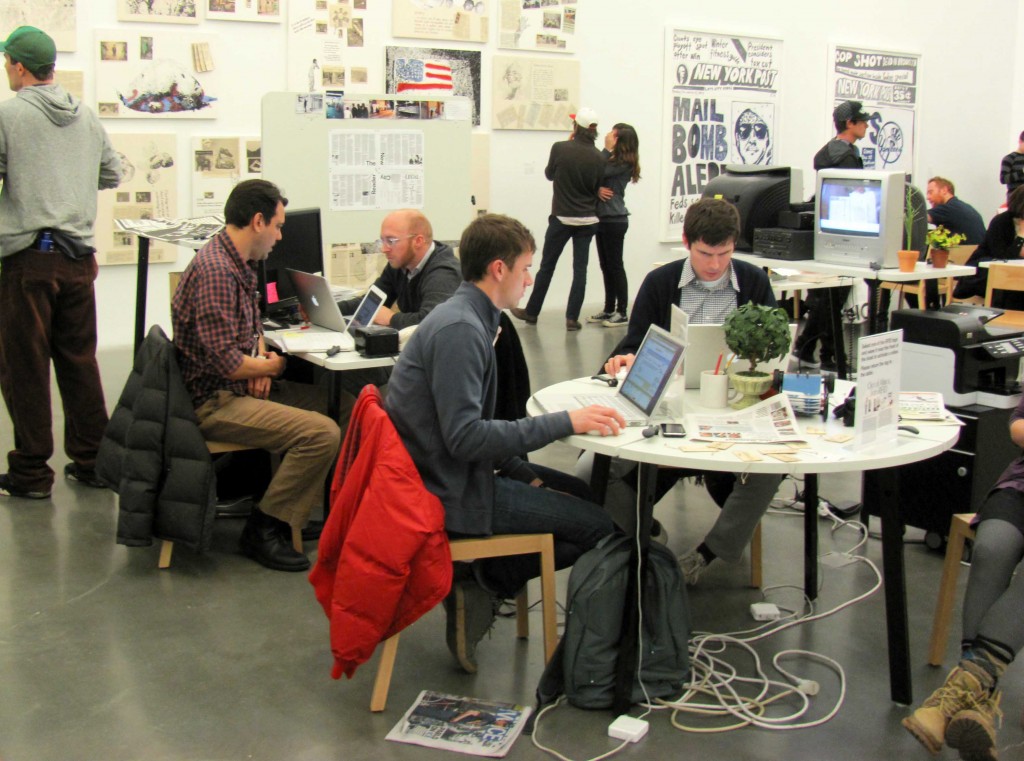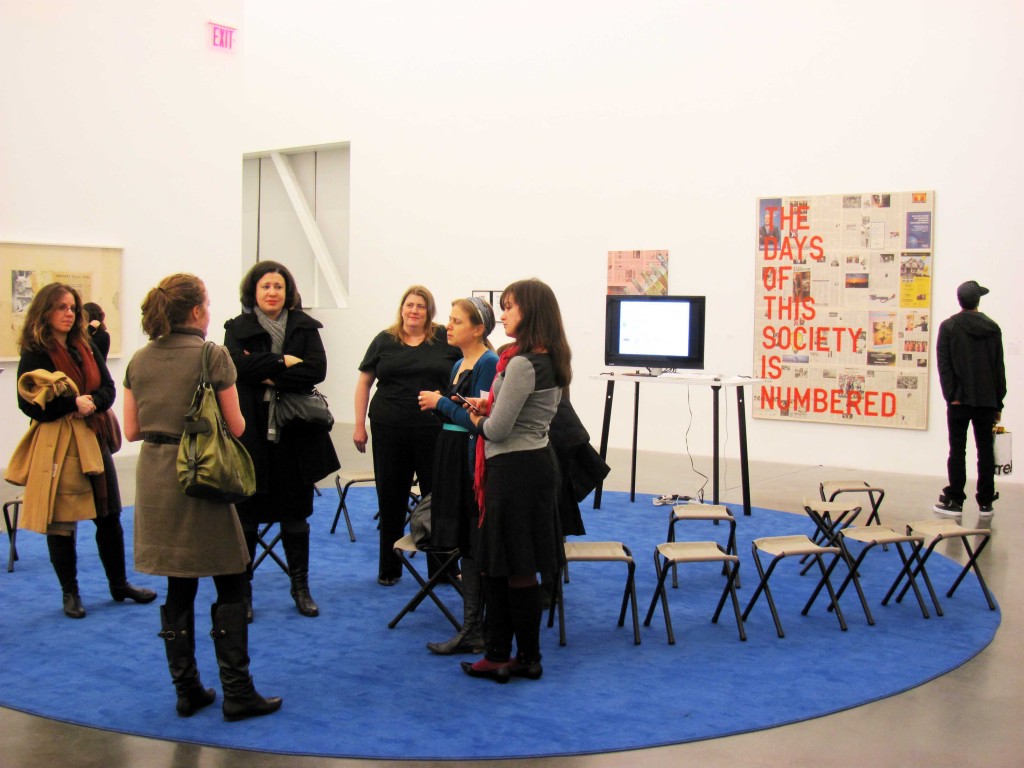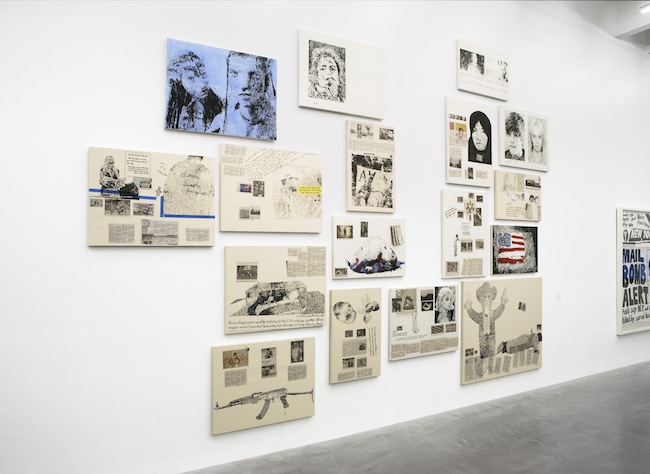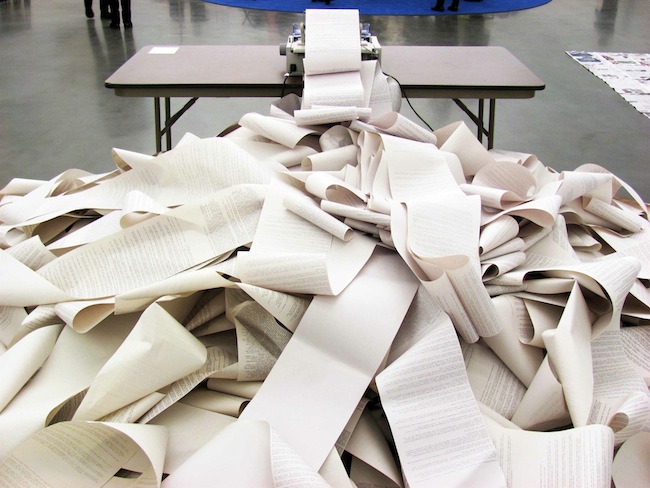
The New Museum’s The Last Newspaper
By Richard Flood, The New Museum’s Director of Special Projects and Curator at Large
From the very beginning, “The Last Newspaper” was intended to be a work in progress. We invited partners to create their own offices which would operate throughout the course of the exhibition. The office components were specially designed by Blue Dot furniture as a “kit of parts” and, within minutes of its arrival, our partners were setting up their workspaces and carving off the floor in a series of interactive units. Over time, the office scapes underwent a number of changes as the partners expanded and contracted their programs. The other completely flexible domain was a large circle of carpet, fully equipped with forty folding stools, which became the meeting place for conversations, lectures, editorial meetings, classes, reading groups, and DJ-ing. The circle was the brainchild of the Slought Foundation who brought their Perpetual Peace Project to the museum and acted as the show’s ad hoc editorial department.
The most obvious ongoing initiatives were our two weekly newspapers, “The Last Paper” and “New City Reader”. The former was the brainchild of the Barcelona-based curatorial office, Latitudes; the latter the collaborative creation of Kazys Varnellis the director of Colombia University’s Netlab and Joseph Grima of the magazine Domus. “The Last Newspaper” continues to function as the catalogue for the exhibition (10 issues collected in customized wrapper) and the “Reader’s” fourteen sections (2 to go) will soon be collected as one edition and made available through the New Museum. It’s been wonderful publishing two papers a week and having the pleasure of watching museum goers coming back each week so that they can add to their collection. It was also extremely exciting hosting open editorial meetings in the galleries so that the public could actually listen in on the process of creating a paper.
Our partnership with Story Corps also led to wonderful interactions in the galleries. The incredible humanity present in the information in their office deeply touched many visitors. The understanding that we are all one was a paramount realization that was present in all of their programming and the intergenerational stories that they were sharing in videos and animations. Their targeted outreach to librarians brought many professionals to Slought’s carpet circle for training and sharing sessions as to how to best utilize Story Corps’ oral histories with their public.
For a curator, there is nothing as satisfying as a gift that keeps on giving and for “The Last Newspaper” that gift was the artist, Nate Lowman. Before the exhibition began I and my co-curator, Benjamin Godsill, visited Lowman and asked if he might be interested in committing to a project that would continue through the run of the show. He immediately came up with the idea of creating a painting every week that was evolved from what caught his eye in the previous week’s newspaper. On January 7, Lowman arrived with his 26th painting. It was installed high up on a wall which had gone viral with his constantly expanding installation and looked out over the publishing offices which were operating on parallel schedules. The result is a single, multi-component work of art.
Finally, the single most active participant in the exhibition was Hans Haacke’s “News” (1969 – 2008), which spewed out hundreds of feet of news five days a week. Fed by thirty wire services, rolls of breaking news spread out over the gallery floor like the train of an enormous wedding gown. There were moments of incredible coincidence when someone watching the output suddenly spied something of incredible relevance to them. One of our colleagues from the Beirut Art Center, for example, saw the first of the Wiki Leaks detailing our state department’s anxiety as to the future of democracy in Lebanon. What has proven repeatedly rewarding with “The Last Newspaper” is that the news continued to be reported and the exhibition never relaxed or went to sleep. As a curator, the great pleasure was working on a project that was so communally alive.


